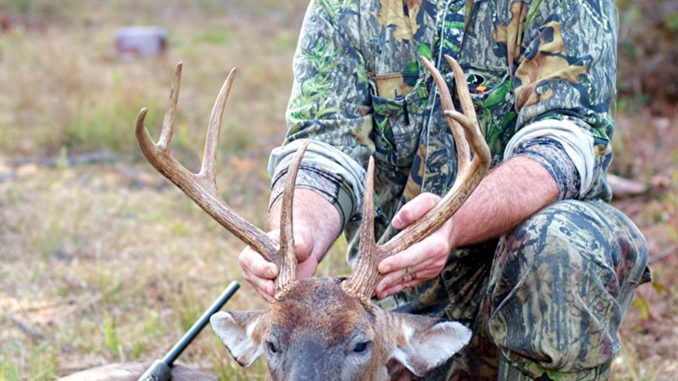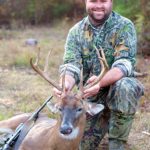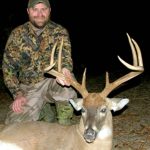
Even your odds by making it easy for a big buck to make a big mistake this month.
Deer hunting in November can be easy on the one hand and difficult on the other. Sitting in a tree stand overlooking an area where a rut-crazed buck is looking for lonely does often makes a novice wonder why folks consider deer hunting to be a challenge when a big racked deer throws caution to the wind and acts like a lovesick teenager.
But try planning on killing a trophy buck, especially one you’ve previously identified on a trail camera, and it’s a game of Spy-vs-Spy, with the odds definitely in the deer’s favor.
With that said, too many trophy bucks are killed each season by hunters who planned on killing a nice deer, even a specific deer, for the game to be simply random luck or chance. Those hunters have a strategy; they planned their work and worked their plan.
C.J. Brown of Edgefield falls into that category. Each season, Brown spends a tremendous amount of time trying to arrange an encounter with trophy deer. Most of the time, those encounters occur during the period between Halloween and Thanksgiving.
Most of the time, Brown hunts on Cowden Plantation, a well-managed 10,000-acre piece of property in Aiken just north of the Savannah River Site. The season opens in his part of the world on Aug. 15, so by early November, bucks are well aware that the season has been open for a while and death may be lurking around the corner. To counter the hunting pressure that drives many bucks nocturnal, Brown relies on other factors that will have a trophy buck on its feet when the sun is up.
“The period from late October to late November is my favorite time of year to hunt,” Brown said. “If you see a rut in South Carolina, that’s the time you see it. You see deer chasing and running, scraping and rubbing. But it’s funny, a lot of times I see the biggest deer where I see the least amount of buck sign.”
“I think a lot of scrapes are made at night,” he said. “A lot of other buck/doe positioning goes on at night, so I try to hunt areas where I think deer might be in the daytime — which means I hunt a lot of bedding areas.”
The timing of the rut is a matter for some discussion across South Carolina. The period from Oct. 15 to Nov. 15 is historically seen as the time of peak breeding across the majority of the state, but Brown said other factors will influence the best time to find a trophy buck out in the open.
“I think weather plays a big part of it,” he said. “If we get cooler weather, sometimes I think it’ll kick into gear a little earlier. I think our deer have an opportunity to breed over a longer period than anywhere else because of the weather. I think it’s really hard to pinpoint and say, ‘This is the best time to go.’ But we do kill a lot of the big deer end of October, first part of November.”
To coincide with rutting activity, Brown keys on the moon to signal what to expect, even though rutting activity may not take place at exactly the same time across an area or even on the same piece of property.
“After that first full moon in November seems to be a good time for seeing some of our better deer,” he said, “but the rut is tricky. The property we hunt is traditional farmland on the front side — big soybean fields, big cotton fields, big corn fields — and it seems like the rut can be in on half the property, but then you go into the swamp, it may seem like the rut isn’t taking place or if it ever takes place.”
Hunting bedding areas is a risky though often effective tactic, if it’s done correctly. Two things that Brown insists on are taking precautions to avoid being detected and making sure he at least has a good idea of what he’s looking for.
“We wear rubber boots every time we step in the woods and use a lot of the products designed to eliminate human scent,” he said. “Doesn’t matter if we’re going to put corn out or we’re going to sit in the stand, we’re treating every outing as a potential encounter with a big buck. We try not to molest the honey holes we’ve made. I think the bigger deer recognize when they’re being targeted. They’re not dumb. Anytime you can minimize your impact on your little honey hole, I think it’s certainly important. ”
Brown believes that while an occasional buck might migrate into an area from a neighboring property as the rut approaches, he likes to know his quarry well in advance and have up-to-date info on his movements from several of the trail cams he uses.
“We keep about a dozen trail cameras out in the woods at all times,” he said. “At this point in the season, we’ve been keeping up with our bigger deer all through the summer, and we continue that through the season. When we locate a big deer, we may change up our tactics to hunt him, just depending on where he’s at. We’ve got some deer on camera right now that don’t look like South Carolina deer, and those suckers are hard to hunt.”
Despite the risk of bumping a deer, Brown said hunting near — or rather over the top of — bedding areas has been productive for him. Things like wind direction, the path he uses to get to his stand and even the stand type and placement are important considerations, but there’s nothing like looking down on a big deer who thinks he’s hidden away in a safe area.
“I like to get in there with them in their bedding area,” said Brown.“ I like to get up high where he can’t see me or smell me and get close to him. That’s been real effective for me. When they’ve been hunted hard for a couple of months, I feel like that’s the best way to catch him off guard. Get in there close. Hunt only good winds. Hunt real thick places.”






Be the first to comment